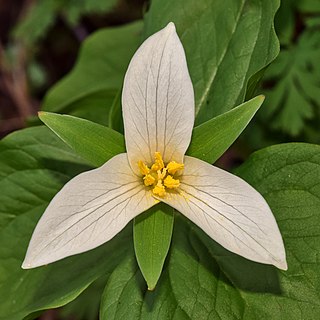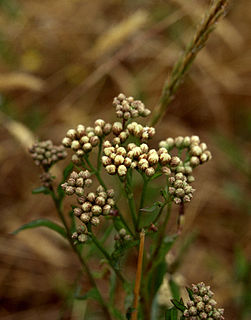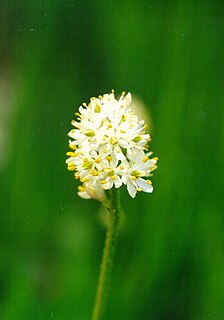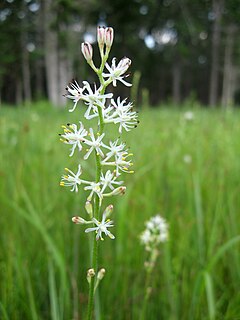
Trillium erectum, the red trillium, also known as wake robin, purple trillium, bethroot, or stinking Benjamin., is a species of flowering plant in the family Melanthiaceae. The plant takes its common name "wake robin" by analogy with the European robin, which has a red breast heralding spring. Likewise Trillium erectum is a spring ephemeral whose life-cycle is synchronized with that of the forests in which it lives. It is native to the eastern United States and eastern Canada from northern Georgia to Quebec and New Brunswick.

Goldenrod is a common name for many species of flowering plants in the sunflower family, Asteraceae, commonly in reference to the genus Solidago.

Grindelia (gumweed) is a genus of plants native to the Americas belonging to the sunflower family. The genus was named for Latvian botanist David Hieronymus Grindel, 1776–1836.

Maianthemum racemosum, the treacleberry, feathery false lily of the valley, false Solomon's seal, Solomon's plume or false spikenard, is a species of flowering plant native to North America. It is a common, widespread plant with numerous common names and synonyms, known from every US state except Hawaii, and from every Canadian province and territory, as well as from Mexico.

Iris lacustris, the dwarf lake iris, is a plant species in the genus Iris, subgenus Limniris and in the section Lophiris. It is a rhizomatous, beardless perennial plant, native to the Great Lakes region of eastern North America. It has lavender blue or violet-blue flowers, a very short stem and long fan-like green leaves. It is cultivated as an ornamental plant in temperate regions. It is closely related to Iris cristata.

Trillium ovatum, the Pacific trillium, also known as the western wakerobin, western white trillium, or western trillium, is a species of flowering plant in the family Melanthiaceae. It is found in western North America, from southern British Columbia and the tip of southwestern Alberta to central California, east to Idaho and western Montana. There is an isolated population in northern Colorado and southern Wyoming.

Trillium flexipes, known as the nodding wakerobin, bent trillium, or drooping trillium, is a species of flowering plant in the family Melanthiaceae. It is found from Minnesota to Ohio, south to Tennessee, with isolated populations in New York, Pennsylvania, Alabama, and other states. It is an endangered species in Ontario and possibly extirpated in North Carolina.

Primula meadia, the shooting star or eastern shooting star, is a species of flowering plant in the primrose family Primulaceae. It is native to the eastern United States and Canada, spanning north from Manitoba and New York, south to Texas and Florida.

Baccharis glutinosa is a species of flowering plant in the daisy family known by the common names saltmarsh baccharis and Douglas' falsewillow.

Maianthemum stellatum is a species of flowering plant, native across North America. It has been found in northern Mexico, every Canadian province and territory except Nunavut, and from every US state except Hawaii and the states of the Southeast. It has little white buds in the spring, followed by delicate starry flowers, then green-and-black striped berries, and finally deep red berries in the fall.

Tofieldia pusilla is a species of flowering plant in the family Tofieldiaceae. It is also sometimes classified in the lily family, Liliaceae. Its common name is Scottish asphodel in Europe, and Scotch false asphodel in North America. The plant is native to northern North America and parts of Eurasia, its circumpolar distribution extending across Canada and the northern United States to Greenland, Iceland and northern Europe.

Artemisia campestris is a common and widespread species of plants in the sunflower family, Asteraceae. It is native to a wide region of Eurasia and North America. Common names include field wormwood, beach wormwood, northern wormwood, Breckland wormwood, boreal wormwood, Canadian wormwood, field sagewort and field mugwort.

Grayson Glades Natural Area Preserve is a 31-acre (13 ha) Natural Area Preserve located in Grayson County, Virginia. Its centerpiece is an extremely rare wetland type known as a "mafic fen", which are situated upon soils rich in magnesium and fed by springs. The site is at the headwaters of a small stream system supporting additional mafic fens.

Tofieldia is a small genus of flowering plants described as a genus in 1778. It is widespread across much of Europe, Asia, and North America.

Triantha is a small genus of flowering plants in the family Tofieldiaceae, first described as a genus in 1879. False asphodel is a common name for plants in this genus.

Triantha racemosa, commonly called the coastal false asphodel or southern bog asphodel, is a species of flowering plant in the Tofieldia family. It is native to the Coastal Plain of the Southeastern United States, although there are a few disjunct populations inland. It is found in acidic wetlands, including wet barrens and savannas.

Eremophila glutinosa, commonly known as sticky emu bush, is a flowering plant in the figwort family, Scrophulariaceae and is endemic to Western Australia. It is an erect, densely foliaged shrub with branches and leaves sticky and shiny due to the presence of resin. It has hairy sepals and lilac-coloured flowers.
Dasymalla glutinosa is a flowering plant in the mint family Lamiaceae and is endemic to Western Australia. It is a spreading, sticky shrub with glabrous branches, egg-shaped, stalkless leaves and small, white or cream-coloured, tube-shaped flowers.

Hypericum fasciculatum, known as peelbark St. Johnswort or sandweed, is a species of flowering plant in the St. Johnswort family, Hypericaceae, native to the southeastern United States. It is found from eastern North Carolina, south to southern Florida, west to eastern Louisiana. Kew's Plants of the World Online database also notes that it occurs in Cuba, though Cuba is not listed in several other sources. It was first described in 1797 by Jean-Baptiste Lamarck.

Triantha occidentalis, the western false asphodel, is a species of flowering plant in the family Tofieldiaceae. It is found in the Pacific Northwest.


















